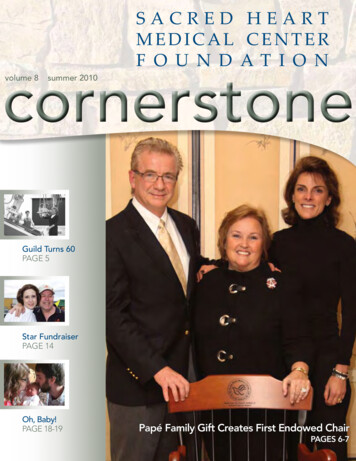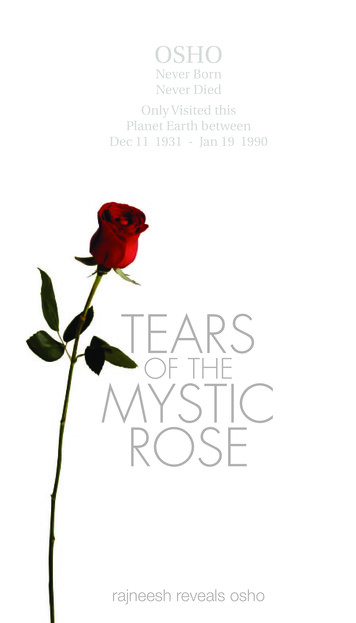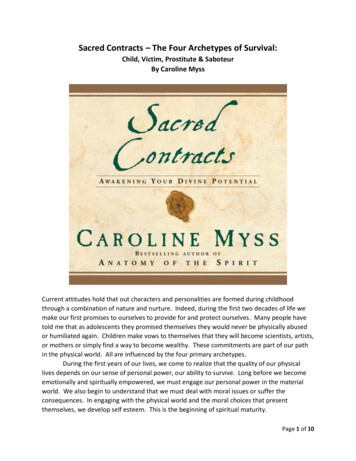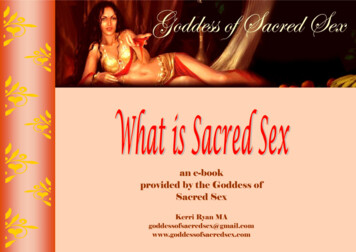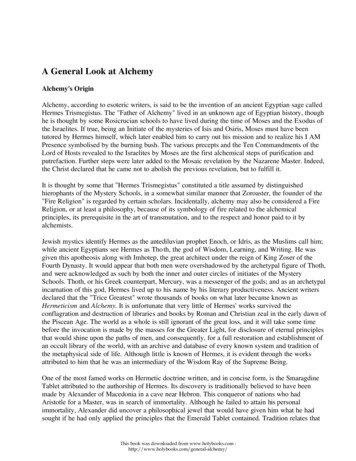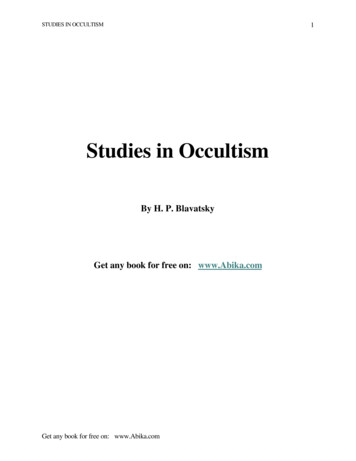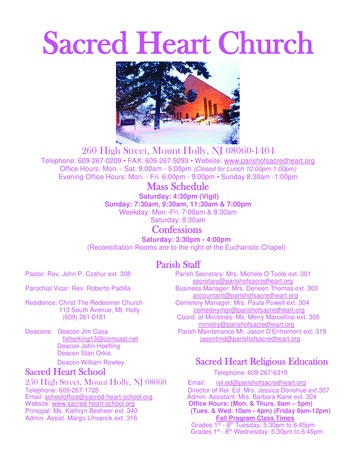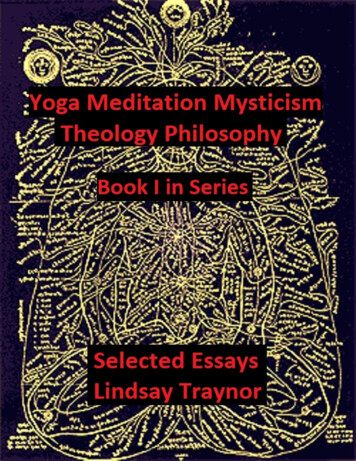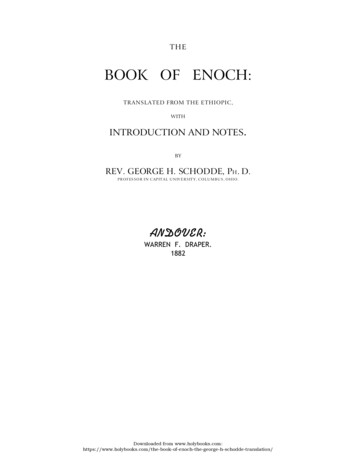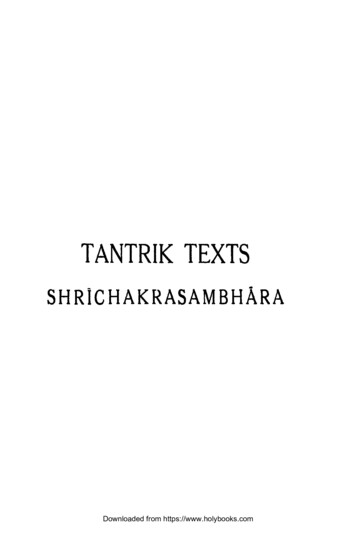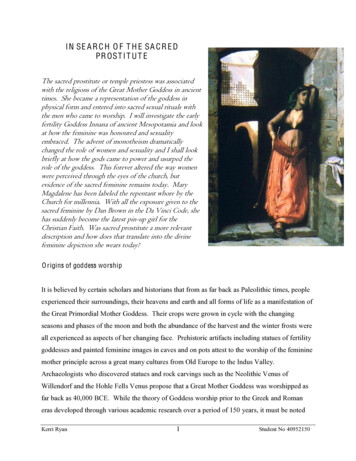
Transcription
I N SE A R C H O F T H E SA C R E DPR OST I T U T EThe sacred prostitute or temple priestess was associatedwith the religions of the Great Mother Goddess in ancienttimes. She became a representation of the goddess inphysical form and entered into sacred sexual rituals withthe men who came to worship. I will investigate the earlyfertility Goddess Innana of ancient Mesopotamia and lookat how the feminine was honoured and sexualityembraced. The advent of monotheism dramaticallychanged the role of women and sexuality and I shall lookbriefly at how the gods came to power and usurped therole of the goddess. This forever altered the way womenwere perceived through the eyes of the church, butevidence of the sacred feminine remains today. MaryMagdalene has been labeled the repentant whore by theChurch for millennia. With all the exposure given to thesacred feminine by Dan Brown in the Da Vinci Code, shehas suddenly become the latest pin- up girl for theChristian Faith. Was sacred prostitute a more relevantdescription and how does that translate into the divinefeminine depiction she wears today?O rigins of goddess worshipIt is believed by certain scholars and historians that from as far back as Paleolithic times, peopleexperienced their surroundings, their heavens and earth and all forms of life as a manifestation ofthe Great Primordial Mother Goddess. Their crops were grown in cycle with the changingseasons and phases of the moon and both the abundance of the harvest and the winter frosts wereall experienced as aspects of her changing face. Prehistoric artifacts including statues of fertilitygoddesses and painted feminine images in caves and on pots attest to the worship of the femininemother principle across a great many cultures from Old Europe to the Indus Valley.Archaeologists who discovered statues and rock carvings such as the Neolithic Venus ofWillendorf and the Hohle Fells Venus propose that a Great Mother Goddess was worshipped asfar back as 40,000 BCE. While the theory of Goddess worship prior to the Greek and Romaneras developed through various academic research over a period of 150 years, it must be notedKerri Ryan1Student No 40952150
that there is no factual verification that the statues and evidence found, do indeed indicate amatriarchal earth based religion1 and some scholars do not agree with this theory. Many othersdo.The worship of the Goddess Innana can be traced tobefore the 4th millennium BCE. This area wasknown as the cradle of civilization and encompassedlands known as Sumeria, Assyria and Babylon.Innana was the Sumerian goddess of the moon andwas known as Ishtar to the Babylonians and was oneof the three great goddesses of the Bronze Age.The practice of sacred sexual intercourse within thetemples of Innana and Ishtar were important andcommon rituals in Mesopotamia and wereunderstood to reinvigorate the land with divineIHUWLOH HQHUJ\ 7KH SULHVWHVV¶ RI WKH WHPSOH WRRN WKH WLWOH RI ³ LHURGXOH RI HDYHQ 2 which meantµVHUYDQW RI WKH KRO\¶ DQG LW ZDV D JUHDW KRQRXU WR make love within the precincts of the goddess.To understand the sacredness of the sexual act, it must be seen in the context of a society whichlived in close accord with nature. Qualls-Corbet3 explains ³'HVLUH DQG VH[XDO UHVSRQVH experienced as a regenerative power were recognized as a gift or a blessing from the divine.0DQ¶V DQG ZRPDQ¶V VH[XDO QDWXUH DQG WKHLU UHOLJLRXV DWWLWXGH ZHUH LQVHSDUDEOH The sex actwas offered up to the goddess of love and fertility who in return bestowed her blessings offertility and growth upon her petitioners. It is not difficult then to understand that the practice ofsacred prostitution became a religious act of worship where sexuality and spirituality became oneand the same.1Hutton, R. The Triumph of the Moon (p36-39Marvelly, P. Women of Wisdom (p9)3Qualls-Corbet, N. The Sacred Prostitute (p30)2Kerri Ryan2Student No 40952150
In Babylon there was a hierarchy of prostitutes from the high-ranking priestesses known byvarious names including quedishtu, naditu or entu, right down to the tavern or street whore calledharimtu. Ishtar did not differentiate in bestowing her blessings and honoured the sexual acthowsoever it be performed4. "Who will plough my vulva?" calls Inanna in the old hymns."Whowill water the holy lap?"5 The power of the feminine, embodied in the sexuality of all womenboth made the earth grow and was a power for transformation7KH µVDFUHG PDUULDJH¶ DV SHUIRUPHG LQ WKH 1HZ HDU FHOHEUations of Innana and Dumuzi wasknown as heiros gamos. This sacred joining of the king with the high priestess of the templebecame the ritual that ensured the fertility of the land and the power of the king to rule for thecoming year. Starbird6 notes hRZ IRU PLOOHQQLD WKH µVDFUHG PDUULDJH¶ ZDV WKH DQFLHQW ULWXDO performed by numerous cultures across the Mediterranean region where the priestess of thetemple came to embody the very essence of the Goddess in sexual union with those who came topay for the privilege.The temples of the goddess have provided for the sacred prostitute for more millennium than isknown. The story of the legendary King Gilgamesh dates back to 7000BCE7 and explains howthe sacred prostitute tamed the hairy beast who was sent to rob the King, turning him into acivilized companion. The Greek historian Herodotus8 writes in the 3rd century BCE of theBabylonian custom that compels every woman of the land once in her life to sit in the temple ofthe goddess of love and have intercourse with a stranger who must provide a payment for thetemple. The practice is recorded to have taken place in Egypt, Lebanon, Greece and Rome andthe commonly known vestal virgin was not a virgin at all, but rather devoted her life to become a³EULGH in a ritual marriage in the temples of Hestia or Vesta.9 A virgin was considered to be onewho was married to no man, but who lived according to her own choices.4Cunningham, E. Sacred Prostitution: The Whore and the Holy One)URP ³7KH &RXUWVKLS RI ,QQDQD DQG 'XPX]L WUDQVODWHG E\ 6DPXHO 1RDK .UDPHU6Starbird, M. Mary Magdaline Bride in Exile (p 49)7Ibid (p33)8Ibid (p33)9Ibid (p36)5Kerri Ryan3Student No 40952150
Sacred Sexuality in IndiaIndia has historically embraced a rich tradition of religion anddivine sexuality and Hinduism has embraced a naturalistic anderotic attitude towards the behaviour of its gods and goddesses.The worship of the phallus or linga from early times developedinto the God Shiva together with his consort the great mother orfertility goddesses known in modern times as Parvati, Durga andKali. The stories of the ancient pantheon of the Hindu gods andgoddesses can be found in the Upanishad (sacred texts) and theworship of the linga (phallus) and yoni (vagina) is derived fromthe sacred fertility acts which are common to many cultures.The sacred prostitutes were known as devaGDVLV RU µJRG¶V VHUYDQWV¶ DQG ZHUH DWWDFKHG WR WKH service of deities in Hindu temples. This practice continued from antiquity and only faded out inthe late 19th century with the intervention of the appalled British. Girls were given to the templefrom childhood and were married to the deity in a formal wedding ceremony, often beingdeflowered by the priest or made to sit upon a linga stone.10 .Tantra evolved out of the yogic practices of the Buddhists and Hindus and was concerned withthe raising of sexual energy within the body as a way of communion with the divine. In Tantrathe most powerful energy is sexual and the sex organs symbolise cosmic powers within the lingaand yoni. The serpent kundalini energy which sits dormant at the base of the spine is raised upthrough the chakra system to the heart and then out through the crown of the head enabling fullbody orgasm without intercourse nor emission of semen. The sexual union of the male andfemale represent the union of god and the soul (another form of sacred marriage) and becomes ameans for achieving enlightened states.111011Parrinder, G. Sexuality Morality ,Q WKH :RUOG¶V 5HOLJLRQV (p27)Smoley, R & Kinney J Hidden Wisdom (p264)Kerri Ryan4Student No 40952150
T he birth of the masculine godsThe advent of the Bronze Age (3500 BCE to 1250BCE) saw an end to the peaceful, agrarian,communities who worshipped the universal mother concept. The discovery of bronze not onlyallowed for the creation of strong and flexible farming tools, but for powerful weapons of deathand destruction. The relatively peaceful lands of Mesopotamia were soon invaded. Marvellyexplains ³,QYDGLQJ PLJUDWRU\ ZDUULRUV Aryan tribes from the steppe lands between the Dnieperand Volga rivers, north of the Black and Caspian Seas, as well as Semitic tribes from the SyroArabian desert VWDUWHG WR LPSRVH WKHLU RZQ SDWULDUFKDO FXVWRPV 12This began to see the worship of the goddess and the peaceful agricultural based societiesdissipate as men moved into defense roles and survival became the primary focus of daily lives.The ideas of men passing tests of endurance, strength and power, developed into notions of theµKHUR¶ DV WKH UHVW RI WKH WULEH EHJDQ WR ZRUVKLS DQG HPXODWH WKHse feats of bravery. The MotherGoddess began to lose her grip as the belief in death as a cycle of rebirth and renewal began to bereplaced with a fearful finality of death meaning the end. Soon separate male sky gods began toemerge that acknowledged the masculine forces of war and discord that became associated withlightning, thunder, storm and fire.13 The goddess and the sacred feminine and her connectionswith the cycles of the earth were replaced with the masculine principles of war and power and thesubsequent worth of women themselves declined in the same way, to the point where they oftenbecame possessions of men.Men also began to understand their part in procreation and believed that it was the male thatcreated new life, the woman only being the receptacle for the growth. New laws emerged aroundthis and with the advent of politics and commerce, the social order slowly changed. Crossculturalisation also occurred and the beliefs and practices of other lands and the worship of othergods also influenced the social structure. There were many factors involved, but eventually theshift from a matriarchal to a patriarchal society gradually took hold and man established the1213Marvelly, P. Women of Wisdom (p2)Ibid (p2)Kerri Ryan5Student No 40952150
recognition of a supreme masculine sky god in his image, and the attitudes towards the feminineand the goddess of fertility and love changed forever.³2YHU WLPe the temples of love gave way to the house of the Lord, radically displacingZRPDQ¶V UROH LQ UHOLJLRXV ULWHV ,Q WKH ZRUVKLS RI WKH JRGGHVV DV ZH KDYH VHHQ VH[ ZDV brought openly and with reverence to the very altar of the goddess. In her temple, menand woman came to find life and all that it had to offer in sensual pleasure and delight.But with the change in cultural values and institutionalization of monotheism andSDWULDUFK\ WKH LQGLYLGXDO FDPH WR WKH KRXVH RI WKH /RUG WR SUHSDUH IRU GHDWK Qualls-Corbett14T he sacred feminine in monotheismThe very basis of Christianity rests on the tenet that we are all born into original sin. Eve, theembodiment of all things sensual and seductive carries the enormous guilt of having beentempted by evil. By then enticing Adam, she committed the very first sin, having them bothexpelled from the Garden of Eden with the resultant downfall of mankind. Suddenly woman isno longer seen as divine, but a reminder of masculine physical desires which must be resisted atall costs. Women began to be associated with their sexual nature which must be degraded andsuppressed. In order to reach pure spiritual joining with God the Father, denial of the physicalwas paramount and all association with the goddess or the divine feminine were assiduouslycensored by the church. Even the Virgin Mary as the lone figure of matriarchal redemption in theCatholic Church is an emasculated depiction of the goddess, devoid of any sensuality or fertility.Whilst the goddess has generally been erased from the three main monotheistic religions ofChristianity, Judaism and Islam, the sacred feminine has survived and can be found in historicand esoteric writings from early inception. She may not be as obvious as the sacred prostitute,but the divine feminine is found in the creation myths of most religions and her discovery isimportant to a modern reinterpretation of sacred texts.14Qualls-Corbet, N. The Sacred Prostitute (p42-43)Kerri Ryan6Student No 40952150
JudaismJudaism springs from the ancient Hebrew whose attitudes to sex and life in general werenaturalistic and accepting of procreation as the continuing divine creation. Earlier Yahwisticwritings RI WKH *HQHVLV FUHDWLRQ P\WK VDZ ERWK GDP DQG (YH FUHDWHG E\ *RG DV µERQH RI P\ ERQH DQG IOHVK RI P\ IOHVK¶ DQG HTXDO LQ WKH VLJKW RI WKH /RUG 7KH VWRU\ RI WKH µ)DOO¶ WKHLU disobedience and expulsion from Eden was not originally concerned with sexual temptation butUDWKHU GLVREHGLHQFH 7KH GLYLQH FRPPDQG ZDV QRW WR HDW IURP WKH µWUHH RI NQRZOHGJH RI JRRG DQG HYLO¶ DQG WKH RULJLQDO VLQ ZDV µrebellion against God¶, nothing to do with Eve using hersexual wiles to tempt Adam. Their first sexual union did not even happen until they had actuallyleft the Garden of Eden. 15The book of Proverbs explains how Wisdom(also known as Sophia) became the femalecompanion of God that participated in theFUHDWLRQ RI DOO µ The Lord possessed me in thebeginning of his way, before his workV RI ROG « , was beside him like a master workman, and I wasGDLO\ KLV GHOLJKW¶ (Prov 8.22). Wisdom becamean instrument of creation, manifest in thephysical. Later Rabbinical writings in the Torahand Zohar acknowledge Wisdom as the divinefeminine principle and tell us about Solomon whoIHOO LQ ORYH ZLWK :LVGRP¶V EHDXW\. Ochshorn16VSHDNV RI :LVGRP¶V DEVWUDFW IHPDOH personification that has little to do with womenEXW OLNH WKH (J\SWLDQ *RGGHVV 0DDW ³shebecomes the very underpinning of earthly power,justice
Sacred Sexuality in India India has historically embraced a rich tradition of religion and divine sexuality and Hinduism has embraced a naturalistic and erotic attitude towards the behaviour of its gods and goddesses. The worship of the phallus or linga from early times developed into the God Shiva together with his consort the great mother or fertility goddesses known in modern times as .

